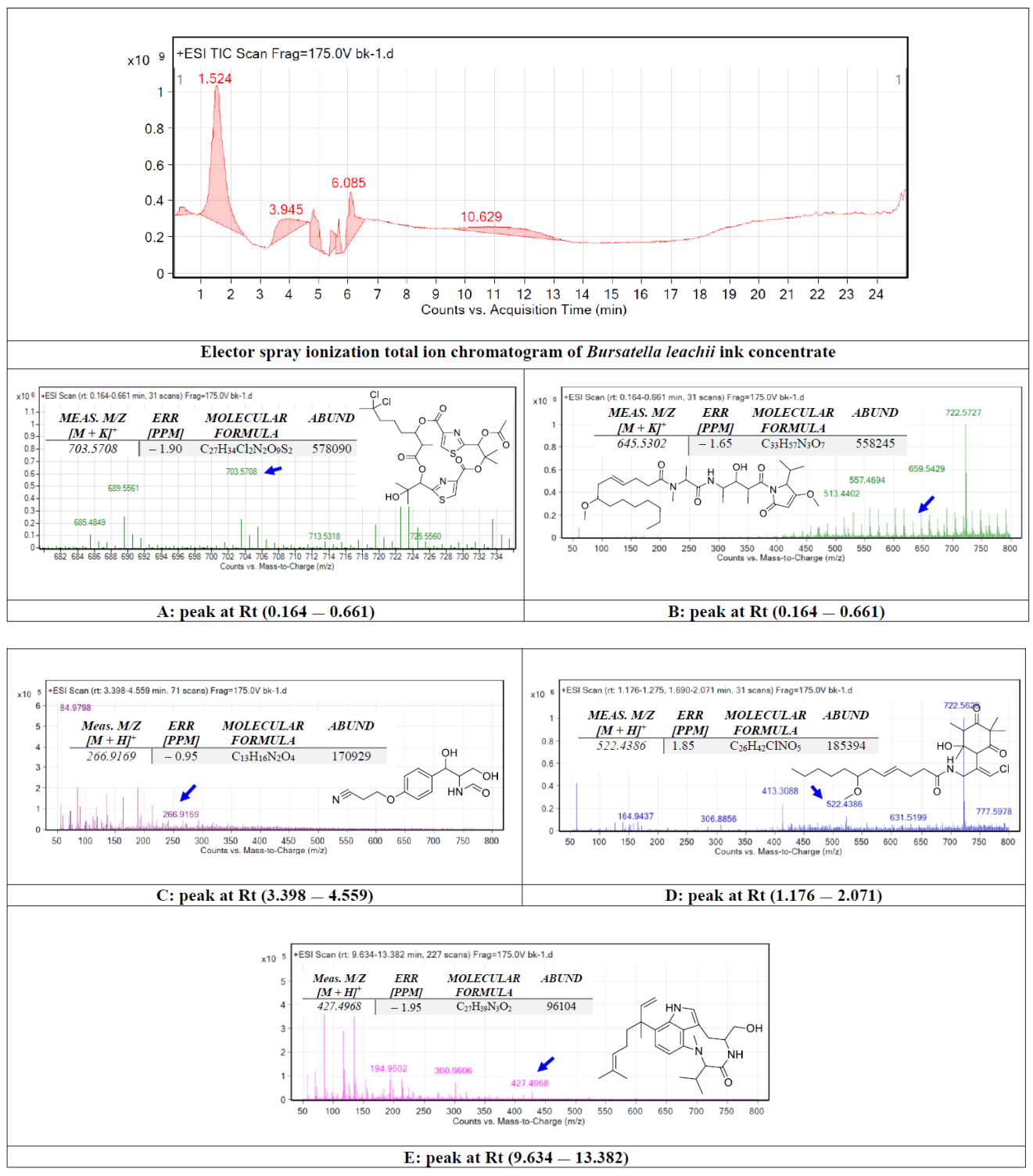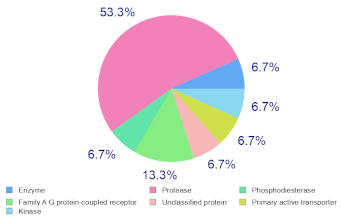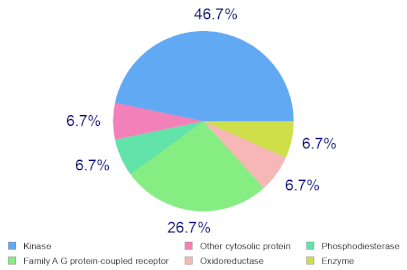Bursatella leachii Purple Ink Secretion Concentrate Exerts Cytotoxic Properties against Human Hepatocarcinoma Cell Line (HepG2): In Vitro and In Silico Studies
Abstract
1. Introduction
2. Results
2.1. Chemical Identification of B. leachii Ink Concentrate Using Liquid Chromatography-Quadrupole Time of Flight (LC-QTOF)
2.2. Cytotoxic Effect of the B. leachii Ink Concentrate
2.3. Induction of Apoptosis by B. leachii Ink Concentrate
2.4. Modulation of Gene Expression Levels of Apoptotic and Cell Cycle Regulatory Genes by B. leachii Ink Concentrate
2.5. B. leachii Ink Concentrate Bioactivity Predictions
2.6. Molecular Target Predictions of B. leachii Ink Concentrate
2.7. Pharmacokinetics Absorption, Distribution, Metabolism and Excretion (ADME) Predictions and Cytochrome (CYP) P450 Enzyme Inhibition Profiling
3. Discussion
4. Materials and Methods
4.1. Collection of B. leachii Ink Concentrate
4.2. Chemicals and Reagents
4.3. Chemical Analysis Using LC-QTOF
4.4. Cell Line and Culture Medium
4.5. Cell Proliferation Assay
4.6. Western Blot Analysis
4.7. Gene Expression Analysis
4.8. Activity Prediction Using PASS Online Webserver
4.9. Target Predictions Using Molinspiration and SwissTargetPrediction Tools
4.10. Pharmacokinetic ADME Predictions and Cytochrome P450 Profiling Using SWISS Tool
4.11. Statistical Analysis
5. Conclusions
Author Contributions
Funding
Institutional Review Board Statement
Data Availability Statement
Conflicts of Interest
Abbreviations
| ADME | absorption distribution metabolism excretion |
| ATP | adenosine triphosphate |
| BBB | blood–brain barrier |
| cDNA | complementary deoxyribonucleic acid |
| CO2 | carbon dioxide |
| DMEM | Dulbecco’s Modified Eagles Medium |
| FBS | foetal bovine serum |
| GAPDH | glyceraldehyde 3-phosphate dehydrogenase |
| GI | gastrointestinal |
| HCC | hepatocellular carcinoma |
| HIV | human immunodeficiency virus |
| IC50 | half-maximal inhibitory concentration |
| Log P | lipid solubility |
| Log S | water solubility |
| mRNA | messenger ribonucleic acid |
| QTOF | quadrupole time of flight |
| ROF | rule-of-five |
| RT-qPCR | reverse transcription-quantitative polymerase chain reaction |
| STS | staurosporine |
References
- Sung, H.; Ferlay, J.; Siegel, R.L.; Laversanne, M.; Soerjomataram, I.; Jemal, A.; Bray, F. Global Cancer Statistics 2020: GLOBOCAN Estimates of Incidence and Mortality Worldwide for 36 Cancers in 185 Countries. CA Cancer J. Clin. 2021, 71, 209–249. [Google Scholar] [CrossRef] [PubMed]
- Okeke, E.; Davwar, P.M.; Roberts, L.; Sartorius, K.; Spearman, W.; Malu, A.; Duguru, M. Epidemiology of Liver Cancer in Africa: Current and Future Trends. Semin. Liver Dis. 2020, 40, 111–123. [Google Scholar] [CrossRef] [PubMed]
- Al-Anazi, M.R.; Matou-Nasri, S.; Al-Qahtani, A.A.; Alghamdi, J.; Abdo, A.A.; Sanai, F.M.; Al-Hamoudi, W.K.; Alswat, K.A.; Al-Ashgar, H.I.; Khan, M.Q.; et al. Association between IL-37 gene polymorphisms and risk of HBV-related liver disease in a Saudi Arabian population. Sci. Rep. 2019, 9, 7123. [Google Scholar] [CrossRef] [PubMed]
- Nishida, N. Metabolic disease as a risk of hepatocellular carcinoma. Clin. Mol. Hepatol. 2021, 27, 87–90. [Google Scholar] [CrossRef]
- Liu, C.Y.; Chen, K.F.; Chen, P.J. Treatment of liver cancer. Cold Spring Harb. Perspect. Med. 2015, 5, a021535. [Google Scholar] [CrossRef]
- Shaaban, S.; Negm, A.; Ibrahim, E.E.; Elrazak, A.A. Chemotherapeutic agents for the treatment of hepatocellular carcinoma: Efficacy and mode of action. Oncol. Rev. 2014, 8, 25–35. [Google Scholar] [CrossRef][Green Version]
- Zhou, Y.; Li, Y.; Zhou, T.; Zheng, J.; Li, S.; Li, H.-B. Dietary Natural Products for Prevention and Treatment of Liver Cancer. Nutrients 2016, 8, 156. [Google Scholar] [CrossRef]
- Yin, B.; Fang, D.-M.; Zhou, X.-L.; Gao, F. Natural products as important tyrosine kinase inhibitors. Eur. J. Med. Chem. 2019, 182, 111664. [Google Scholar] [CrossRef]
- Rajabi, S.; Maresca, M.; Yumashev, A.; Choopani, R.; Hajimehdipoor, H. The Most Competent Plant-Derived Natural Products for Targeting Apoptosis in Cancer Therapy. Biomolecules 2021, 11, 534. [Google Scholar] [CrossRef]
- Szondy, Z.; Sarang, Z.; Kiss, B.; Garabuczi, É.; Köröskényi, K. Anti-inflammatory Mechanisms Triggered by Apoptotic Cells during Their Clearance. Front. Immunol. 2017, 8, 909. [Google Scholar] [CrossRef]
- Strathearn, L.S.; Stepanov, A.I.; Font-Burgada, J. Inflammation in Primary and Metastatic Liver Tumorigenesis–Under the Influence of Alcohol and High-Fat Diets. Nutrients 2020, 12, 933. [Google Scholar] [CrossRef]
- Benkendorff, K. Molluscan biological and chemical diversity: Secondary metabolites and medicinal resources produced by marine molluscs. Biol. Rev. Camb. Philos. Soc. 2010, 85, 757–775. [Google Scholar] [CrossRef]
- Sethi, S.; Kokane, M.R.; Otta, S.K.; Sethi, G. First record of Ragged Sea Hare Bursatella leachii Blainville, 1817 (Opisthobranchia: Euopisthobranchia: Aplysiidae) in Pulicat Lake, east coast of India. Mar. Biodivers. Rec. 2015, 8, e34. [Google Scholar] [CrossRef]
- Zhang, Q.T.; Liu, Z.D.; Wang, Z.; Wang, T.; Wang, N.; Wang, N.; Zhang, B.; Zhao, Y.F. Recent Advances in Small Peptides of Marine Origin in Cancer Therapy. Mar. Drugs 2021, 19, 115. [Google Scholar] [CrossRef]
- Pereira, R.B.; Andrade, P.B.; Valentão, P. Chemical Diversity and Biological Properties of Secondary Metabolites from Sea Hares of Aplysia Genus. Mar. Drugs 2016, 14, 39. [Google Scholar] [CrossRef]
- Pereira, R.B.; Evdokimov, N.M.; Lefranc, F.; Valentão, P.; Kornienko, A.; Pereira, D.M.; Andrade, P.B.; Gomes, N.G.M. Marine-Derived Anticancer Agents: Clinical Benefits, Innovative Mechanisms, and New Targets. Mar. Drugs 2019, 17, 329. [Google Scholar] [CrossRef]
- Rajaganapathi, J.; Kathiresan, K.; Singh, T.P. Purification of Anti-HIV Protein from Purple Fluid of the Sea Hare Bursatella leachii de Blainville. Mar. Biotechnol. 2002, 4, 447–453. [Google Scholar] [CrossRef]
- Kokane, M.R.; Anuradha, V.; Revathi, K. GC MS analysis and in vitro anti-inflammatory activity of purple ink secreted by Bursatella leachii. Eur. J. Biomed. Pharm. Sci. 2019, 6, 212–216. [Google Scholar]
- Suntornchashwej, S.; Chaichit, N.; Isobe, M.; Suwanborirux, K. Hectochlorin and Morpholine Derivatives from the Thai Sea Hare, Bursatella leachii. J. Nat. Prod. 2005, 68, 951–955. [Google Scholar] [CrossRef]
- Suntornchashwej, S.; Suwanborirux, K.; Koga, K.; Isobe, M. Malyngamide X: The First (7R)-Lyngbic Acid that Connects to a New Tripeptide Backbone from the Thai Sea Hare Bursatella leachii. Chem. Asian J. 2007, 2, 114–122. [Google Scholar] [CrossRef]
- Gopichand, Y.; Schmitz, F.J. Bursatellin: A new diol dinitrile from the sea hare Bursatella leachii pleii. J. Org. Chem. 1980, 45, 5383–5385. [Google Scholar] [CrossRef]
- Appleton, D.R.; Sewell, M.A.; Berridge, M.V.; Copp, B.R. A new biologically active malyngamide from a New Zealand collection of the sea hare Bursatella leach. J. Nat. Prod. 2002, 65, 630–631. [Google Scholar] [CrossRef]
- Capper, A.; Tibbetts, I.R.; O’Neil, J.M.; Shaw, G.R. The Fate of Lyngbya majuscula Toxins in Three Potential Consumers. J. Chem. Ecol. 2005, 31, 1595–1606. [Google Scholar] [CrossRef]
- Braga, T.; Rodrigues, M.J.; Pereira, H.; Varela, J.; Barreira, L.; González-Wangüemert, M.; Custódio, L. Bursatella leachiifrom Mar Menor as a Source of Bioactive Molecules: Preliminary Evaluation of the Nutritional Profile, In Vitro Biological Activities, and Fatty Acids Contents. J. Aquat. Food Prod. Technol. 2017, 26, 1337–1350. [Google Scholar] [CrossRef]
- Guicciardi, M.E.; Gores, G.J. Life and death by death receptors. FASEB J. 2009, 23, 1625–1637. [Google Scholar] [CrossRef]
- Fulda, S.; Debatin, K.M. Extrinsic versus intrinsic apoptosis pathways in anticancer chemotherapy. Oncogene 2006, 25, 4798–4811. [Google Scholar] [CrossRef]
- Mantovani, F.; Collavin, L.; Del Sal, G. Mutant p53 as a guardian of the cancer cell. Cell Death Differ. 2019, 26, 199–212. [Google Scholar] [CrossRef]
- Feroz, W.; Sheikh, A.M.A. Exploring the multiple roles of guardian of the genome: P53. Egypt. J. Med. Hum. Genet. 2020, 21, 49. [Google Scholar] [CrossRef]
- de Groot, R.P.; Raaijmakers, J.A.; Lammers, J.W.J.; Koenderman, L. STAT5-dependent cyclin D1 and Bcl-xL expression in Bcr-Abl-transformed cells. Mol. Cell Res. Commun. 2000, 3, 299–305. [Google Scholar] [CrossRef] [PubMed]
- Ha, J.H.; Shin, J.S.; Yoon, M.K.; Lee, M.S.; He, F.; Bae, K.H.; Yoon, H.S.; Lee, C.K.; Park, S.G.; Muto, Y.; et al. Dual-site Interactions of p53 Protein Transactivation Domain with Anti-apoptotic Bcl-2 Family Proteins Reveal a Highly Convergent Mechanism of Divergent p53 Pathways. J. Biol. Chem. 2013, 288, 7387–7398. [Google Scholar] [CrossRef] [PubMed]
- Teruya, T.; Sasaki, H.; Fukazawa, H.; Suenaga, K. Bisebromoamide, a Potent Cytotoxic Peptide from the Marine Cyanobacterium Lyngbya sp.: Isolation, Stereostructure, and Biological Activity. Org. Lett. 2009, 11, 5062–5065. [Google Scholar] [CrossRef]
- Rubio, B.K.; Parrish, S.M.; Yoshida, W.; Schupp, P.J.; Schils, T.; Williams, P.G. Depsipeptides from a Guamanian marine cyanobacterium, Lyngbya bouillonii, with selective inhibition of serine proteases. Tetrahedron Lett. 2010, 51, 6718–6721. [Google Scholar] [CrossRef]
- Taori, K.; Paul, V.J.; Luesch, H. Kempopeptins A and B, Serine Protease Inhibitors with Different Selectivity Profiles from a Marine Cyanobacterium, Lyngbya sp. J. Nat. Prod. 2008, 71, 1625–1629. [Google Scholar] [CrossRef]
- Matthew, S.; Paul, V.J.; Luesch, H. Largamides A–C, Tiglic Acid-Containing Cyclodepsipeptides with Elastase-Inhibitory Activity from the Marine Cyanobacterium Lyngbya confervoides. Planta Med. 2009, 75, 528–533. [Google Scholar] [CrossRef]
- Benet, L.Z.; Hosey, C.M.; Ursu, O.; Oprea, T. BDDCS, the Rule of 5 and drugability. Adv. Drug Deliv. Rev. 2016, 101, 89–98. [Google Scholar] [CrossRef]
- Vennila, R.; Kanchana, S.; Arumugam, M.; Balasubramanian, T. Investigation of antimicrobial and plasma coagulation property of some molluscan ink extracts: Gastropods and Cephalopods. Afr. J. Biochem. Res. 2011, 5, 14–21. [Google Scholar]
- Rameshbabu, S.; Messaoudi, S.A.; Alehaideb, Z.I.; Ali, M.S.; Venktraman, A.; Alajmi, H.; Al-Eidi, H.; Matou-Nasri, S. Anastatica hierochuntica (L.) methanolic and aqueous extracts exert antiproliferative effects through the induction of apoptosis in MCF-7 breast cancer cells. Saudi Pharm. J. 2020, 28, 985–993. [Google Scholar] [CrossRef]
- Alehaideb, Z.; AlGhamdi, S.; Bin Yahya, W.; Al-Eidi, H.; Alharbi, M.; Alaujan, M.; Albaz, A.; Tukruni, M.; Nehdi, A.; Abdulla, M.-H.; et al. Anti-proliferative and pro-apoptotic effects of Calligonum comosum (L’Her.) methanolic extract in human triple-negative MDA-MB-231 breast cancer cells. J. Evid. Based Integr. Med. 2020, 25, 2515690X20978391. [Google Scholar] [CrossRef]
- Livak, K.J.; Schmittgen, T.D. Analysis of relative gene expression data using real-time quantitative PCR and the 2[-Delta Delta C(t)] method. Methods 2001, 25, 402–408. [Google Scholar] [CrossRef]
- Filimonov, D.; Lagunin, A.A.; Gloriozova, T.A.; Rudik, A.; Druzhilovskii, D.S.; Pogodin, P.V.; Poroikov, V.V. Prediction of the Biological Activity Spectra of Organic Compounds Using the Pass Online Web Resource. Chem. Heterocycl. Compd. 2014, 50, 444–457. [Google Scholar] [CrossRef]
- Molinspiration, Cheminformatics. Calculation of Molecular Properties and Bioactivity Score. Available online: http://www.molinspiration.com/cgi-bin/properties (accessed on 11 November 2021).
- Gfeller, D.; Grosdidier, A.; Wirth, M.; Daina, A.; Michielin, O.; Zoete, V. SwissTargetPrediction: A web server for target prediction of bioactive small molecules. Nucleic Acids Res. 2014, 42, W32–W38. [Google Scholar] [CrossRef]
- Daina, A.; Michielin, O.; Zoete, V. SwissADME: A free web tool to evaluate pharmacokinetics, drug-likeness and medicinal chemistry friendliness of small molecules. Sci. Rep. 2017, 7, 42717. [Google Scholar] [CrossRef]
- Lipinski, C.A. Lead- and drug-like compounds: The rule-of-five revolution. Drug Discov. Today Technol. 2004, 1, 337–341. [Google Scholar] [CrossRef]




| Anti-Neoplastic Activity | Probability of Being Active (Pa) | Probability of Being Inactive (Pi) |
|---|---|---|
| Hectochlorin | 0.933 | 0.002 |
| Malyngamide X | 0.295 | 0.231 |
| Malyngamide S | 0.747 | 0.019 |
| Bursatellin | not applicable | not applicable |
| Lyngbyatoxin A | 0.169 | 0.075 |
| Name | Target Prediction (Molinspiration) | Target Prediction (SwissTargetPrediction) | |
|---|---|---|---|
| Hectochlorin | GPCR ligand | −0.09 |  |
| Ion channel modulator | −0.46 | ||
| Kinase inhibitor | −0.46 | ||
| Nuclear receptor-ligand | −0.18 | ||
| Protease inhibitor | 0.1 | ||
| Enzyme inhibitor | −0.08 | ||
| Malyngamide X | GPCR ligand | 0.19 |  |
| Ion channel modulator | −0.44 | ||
| Kinase inhibitor | −0.42 | ||
| Nuclear receptor-ligand | −0.29 | ||
| Protease inhibitor | 0.46 | ||
| Enzyme inhibitor | 0.01 | ||
| Malyngamide S | GPCR ligand | 0.17 |  |
| Ion channel modulator | 0.24 | ||
| Kinase inhibitor | −0.28 | ||
| Nuclear receptor ligand | 0.23 | ||
| Protease inhibitor | 0.32 | ||
| Enzyme inhibitor | 0.32 | ||
| Bursatellin | GPCR ligand | 0.04 | NA |
| Ion channel modulator | −0.22 | ||
| Kinase inhibitor | −0.36 | ||
| Nuclear receptor-ligand | −0.21 | ||
| Protease inhibitor | 0.01 | ||
| Enzyme inhibitor | 0.32 | ||
| Lyngbyatoxin A | GPCR ligand | 0.49 |  |
| Ion channel modulator | 0.2 | ||
| Kinase inhibitor | 0.42 | ||
| Nuclear receptor ligand | 0.06 | ||
| Protease inhibitor | 0.36 | ||
| Enzyme inhibitor | 0.35 | ||
| Compound Name | Molecular Weight | Log Po/w (WLOGP) | Log S (SILICOS- IT) | BBB Permeant | GI Absorption | Rule of Five (ROF) |
|---|---|---|---|---|---|---|
| Hectochlorin | 665.60 g/mol | 5.09 | −6.86 Poorly soluble | No | Low | No; 2 violations: MW > 500, NorO > 10 |
| Malyngamide X | 607.82 g/mol | 3.98 | −5.07 Moderately soluble | No | High | Yes; 1 violation: MW > 500 |
| Malyngamide S | 484.07 g/mol | 4.73 | −6.25 Poorly soluble | No | High | Yes; 0 violations |
| Bursatellin | 264.28 g/mol | −0.21 | −2.39 Soluble | No | High | Yes; 0 violations |
| Lyngbyatoxin A | 437.62 g/mol | 4.09 | −6.69 Poorly soluble | Yes | High | Yes; 0 violations |
| Compound Name | CYP1A2 Inhibitor | CYP2C19 Inhibitor | CYP2C9 Inhibitor | CYP2D6 Inhibitor | CYP3A4 Inhibitor |
|---|---|---|---|---|---|
| Hectochlorin | No | No | No | No | No |
| Malyngamide X | No | Yes | No | No | Yes |
| Malyngamide S | No | Yes | No | Yes | Yes |
| Bursatellin | No | No | No | No | No |
| Lyngbyatoxin A | No | Yes | Yes | No | Yes |
Publisher’s Note: MDPI stays neutral with regard to jurisdictional claims in published maps and institutional affiliations. |
© 2022 by the authors. Licensee MDPI, Basel, Switzerland. This article is an open access article distributed under the terms and conditions of the Creative Commons Attribution (CC BY) license (https://creativecommons.org/licenses/by/4.0/).
Share and Cite
Alehaideb, Z.I.; Venkatraman, A.; Kokane, M.; Mohamed, S.A.; Rameshbabu, S.; Suliman, R.S.; Alghamdi, S.S.; Al-Eidi, H.; Alghanem, B.; Abdulla, M.-H.; et al. Bursatella leachii Purple Ink Secretion Concentrate Exerts Cytotoxic Properties against Human Hepatocarcinoma Cell Line (HepG2): In Vitro and In Silico Studies. Molecules 2022, 27, 826. https://doi.org/10.3390/molecules27030826
Alehaideb ZI, Venkatraman A, Kokane M, Mohamed SA, Rameshbabu S, Suliman RS, Alghamdi SS, Al-Eidi H, Alghanem B, Abdulla M-H, et al. Bursatella leachii Purple Ink Secretion Concentrate Exerts Cytotoxic Properties against Human Hepatocarcinoma Cell Line (HepG2): In Vitro and In Silico Studies. Molecules. 2022; 27(3):826. https://doi.org/10.3390/molecules27030826
Chicago/Turabian StyleAlehaideb, Zeyad I., Anuradha Venkatraman, Mahadev Kokane, Syed Ali Mohamed, Saranya Rameshbabu, Rasha S. Suliman, Sahar S. Alghamdi, Hamad Al-Eidi, Bandar Alghanem, Maha-Hamadien Abdulla, and et al. 2022. "Bursatella leachii Purple Ink Secretion Concentrate Exerts Cytotoxic Properties against Human Hepatocarcinoma Cell Line (HepG2): In Vitro and In Silico Studies" Molecules 27, no. 3: 826. https://doi.org/10.3390/molecules27030826
APA StyleAlehaideb, Z. I., Venkatraman, A., Kokane, M., Mohamed, S. A., Rameshbabu, S., Suliman, R. S., Alghamdi, S. S., Al-Eidi, H., Alghanem, B., Abdulla, M.-H., & Matou-Nasri, S. (2022). Bursatella leachii Purple Ink Secretion Concentrate Exerts Cytotoxic Properties against Human Hepatocarcinoma Cell Line (HepG2): In Vitro and In Silico Studies. Molecules, 27(3), 826. https://doi.org/10.3390/molecules27030826









